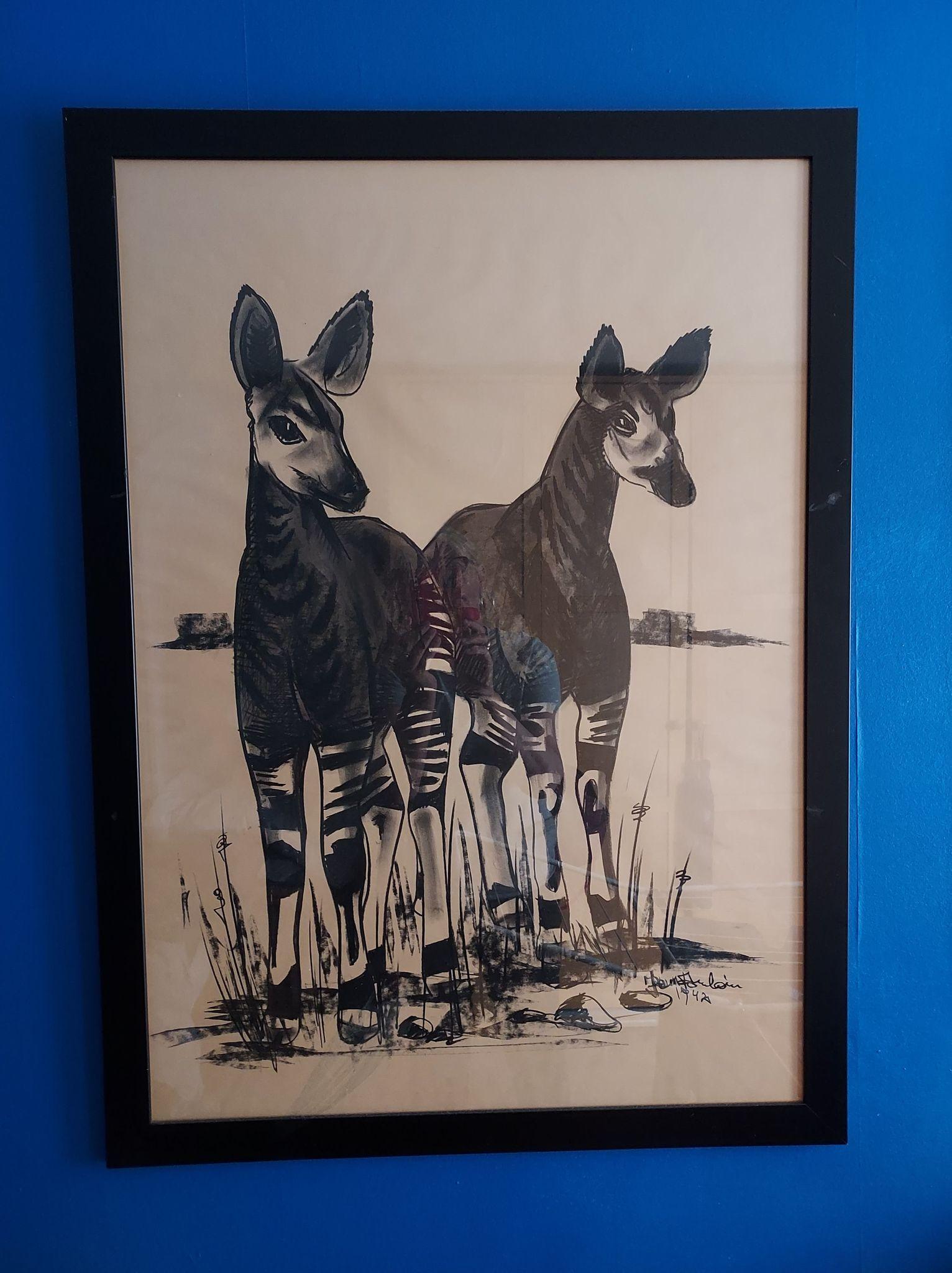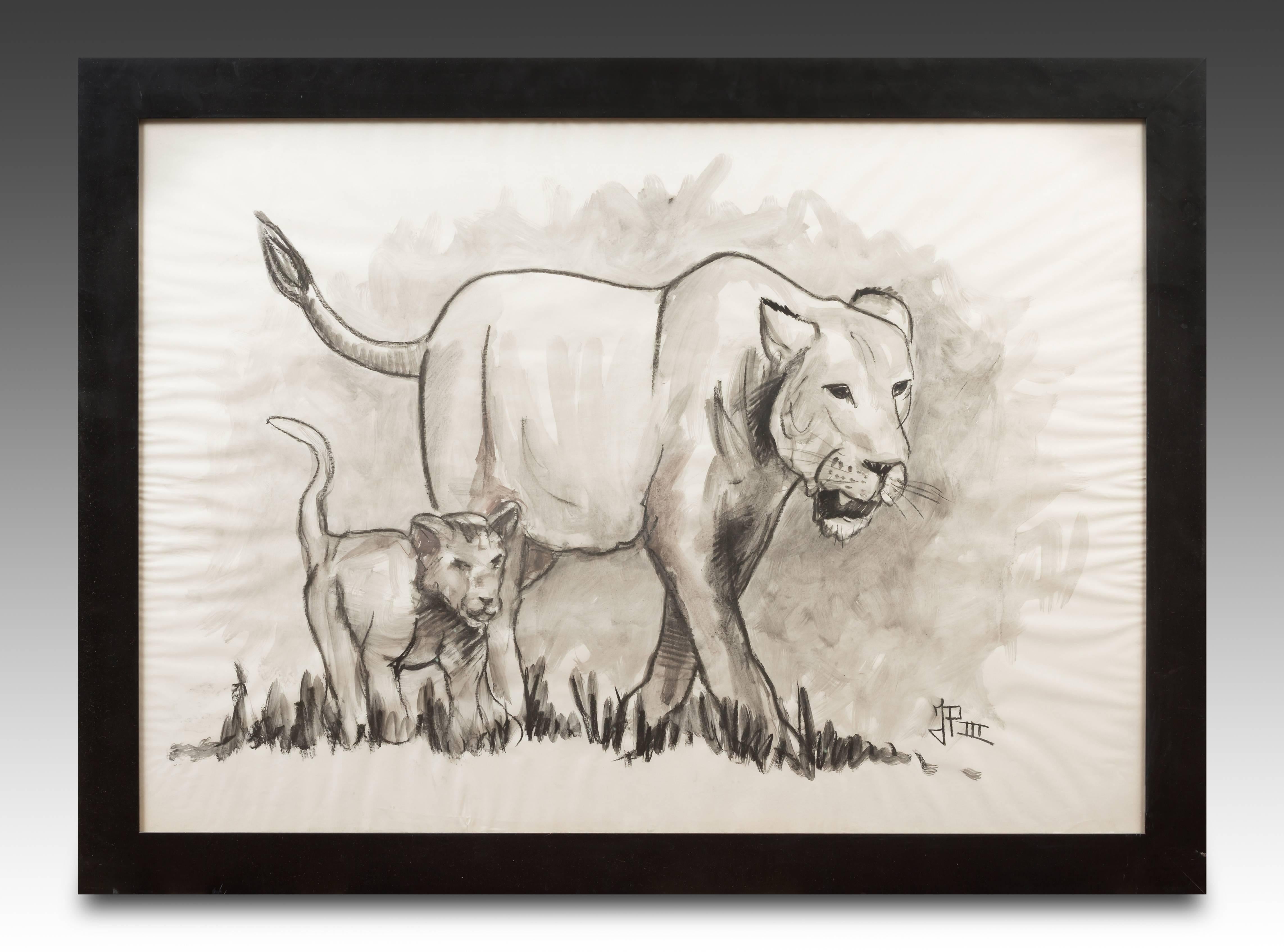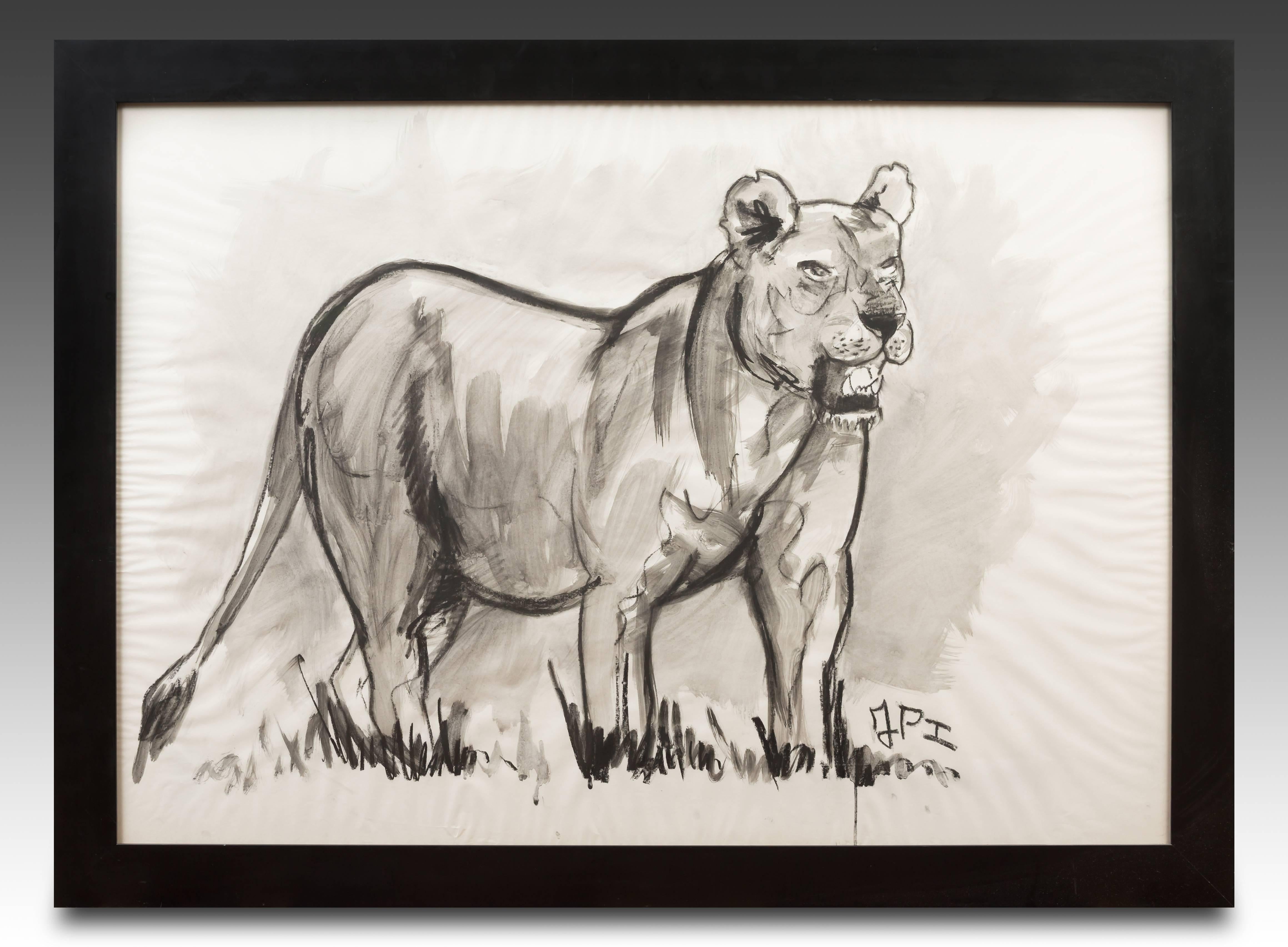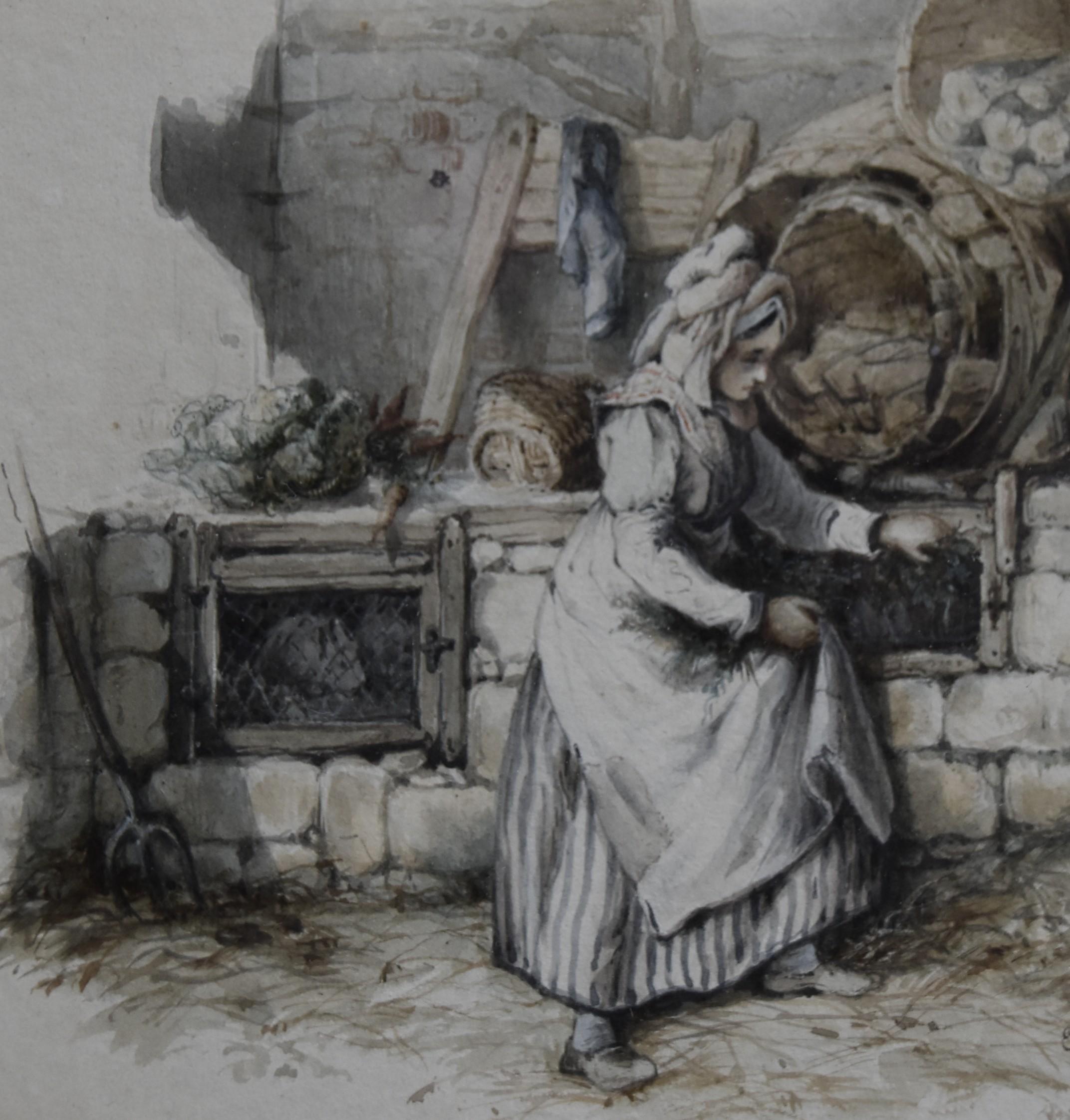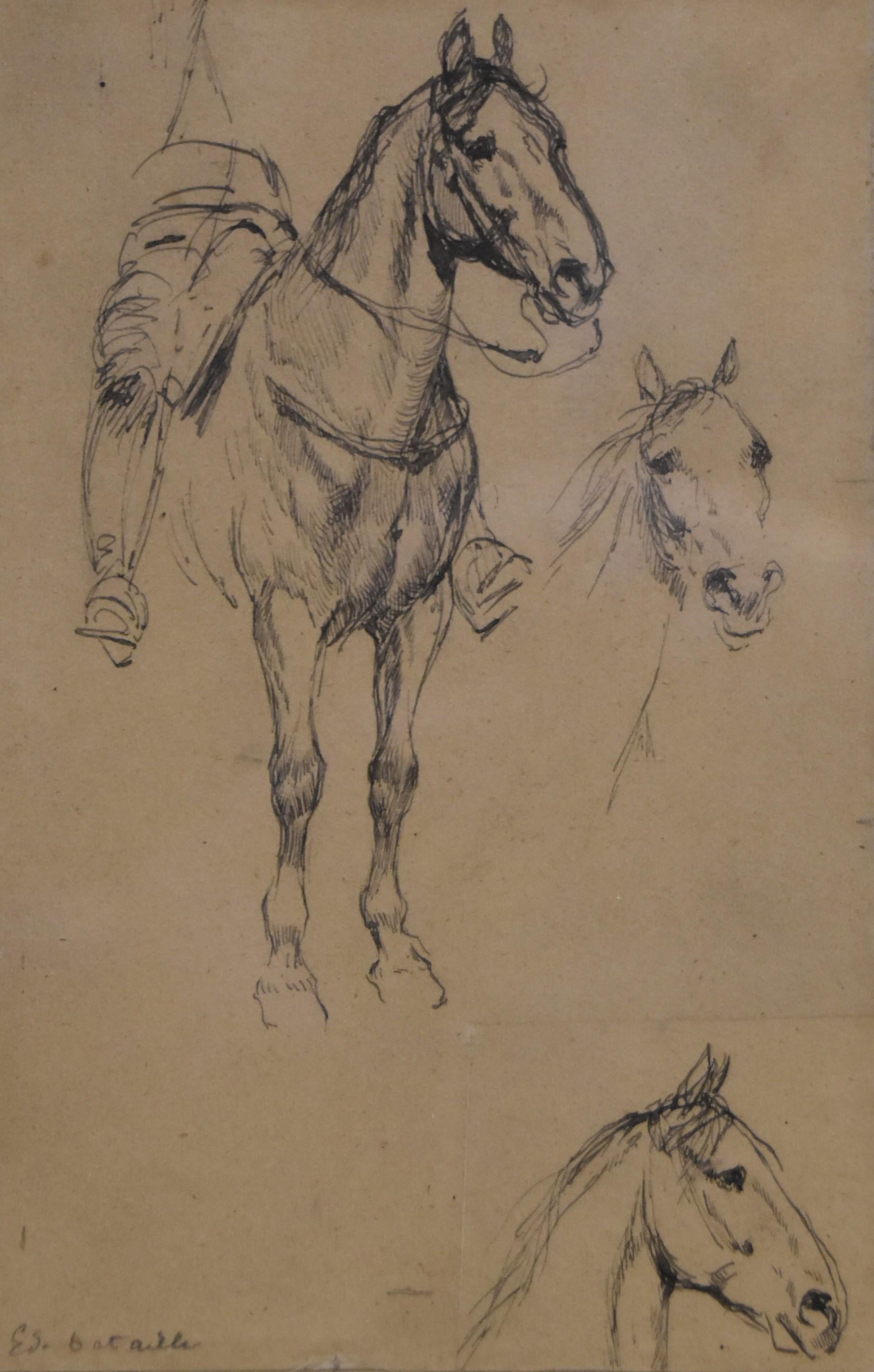Items Similar to Feeding the Kittens - Little cat mother -
Want more images or videos?
Request additional images or videos from the seller
1 of 8
Ernst Albert Fischer-CörlinFeeding the Kittens - Little cat mother -1893
1893
About the Item
Ernst Albert Fischer-Cörlin (1853 Körlin - 1932 Persante). Feeding the Kittens, 1893. Pencil on painting cardboard, 38 x 29 cm. Signed and dated by the artist at lower left "E[rnst] A[lbert] Fischer=Cörlin 1893".
- Lightly stained, somewhat dusty and minimally foxed.
- Little cat mother -
About the artwork
Daughter, mother and grandmother gather in the sunlight to feed a litter of kittens. The mother and grandmother hold the lively, playful animals in their arms, while the young girl feeds two of the four kittens with cookies. There is also a small bucket of milk and a bowl of milk. The women and the girl watch as the cute, still blind animals eat.
It is a scene taken from everyday life, but it also has an allegorical dimension, bringing maternal care into the representation. Three generations are represented, with the grandmother and the mother already mothers. They not only offer the kittens to the youngest, but also proudly observe the maternal care that the youngest gives to the kittens. Like the kittens, she will grow up and become a mother herself, so the image is also an allegory of life's ever-new beginnings. In keeping with this, the morning sun shines into the picture from the right. Fischer-Cörlin has masterfully worked out the quality of the light, with its light and dark areas, with the pencil used for hatching, which is particularly evident in the mother's face and the weave of her hat.
Although the half-timbered house in the background is uniquely laid out, it is not a sketch but a fully formulated pictorial idea and thus an independent work of art, signed and dated accordingly.
About the artist
Ernst Albert Fischer-Cörlin studied at the Berlin Academy of Arts under Eduard Daege and Julius Friedrich Anton Schrader. He then spent six years as a master student of Anton von Werner and was probably a member of Werner's staff for major commissions. After graduating from the academy, he worked as a freelance artist in Berlin.From 1877 to 1892 he participated in the exhibition of the Prussian Academy, from 1893 in the Great Berlin Art Exhibition, and also in the Great Dresden Art Exhibition. In addition, Fischer-Cörlin became a sought-after illustrator, whose pictures adorned several Stollwerck albums. He was also a virtuoso in the artistic design of baptismal certificates, diplomas and certificates of all kinds.
Selected Bibliography
Thieme-Becker. Allgemeines Lexikon der Bildenden Künstler von der Antike bis zur Gegenwart. Begründet von Ulrich Thieme und Felix Becker. Band 12: Fiori–Fyt, Leipzig 1916, S. 20.
Sauer. Allgemeines Künstlerlexikon. Die Bildenden Künstler aller Zeiten und Völker (AKL). Band 40, München u. a. 2004, S. 422.
GERMAN VERSION
Ernst Albert Fischer-Cörlin (1853 Körlin – 1932 Persante). Fütterung der Kätzchen, 1893. Bleistift auf Malkarton, 38 x 29 cm. Links unten eigenhändig signiert und datiert „E[rnst] A[lbert] Fischer=Cörlin 1893.“
- lichtrandig, etwas angestaubt und minimal stockfleckig
- Die kleine Katzenmutter -
zum Kunstwerk
Wohl Tochter, Mutter und Großmutter haben sich im Sonnenlicht versammelt, um einen Wurf Kätzchen zu füttern. Die Mutter und die Großmutter halten die quirlig verspielten Tiere auf den Armen, während das junge Mädchen zwei der vier Kätzchen mit Gebäck füttert. Zusätzlich steht ein kleiner Milcheimer und eine Schale Milch bereit. Die Frauen und das Mädchen betrachten die possierlichen, noch blinden Tiere bei der Nahrungsaufnahme.
Eine aus dem Alltag gegriffene Szenerie, die aber auch eine allegorische Dimension beinhaltet und die mütterliche Fürsorge zur Darstellung bringt. Es sind drei Generationen gezeigt, wobei die Großmutter und die Mutter bereits Mütter sind. Sie bieten der Jüngsten die Kätzchen nicht allein dar, sondern gewahren voll stolzer Aufmerksamkeit auch die mütterliche Fürsorge, welche die Kleinste den Kätzchen entgegenbringt. Wie die Kätzchen wird auch sie heranwachsen und selbst zur Mutter werden, so dass das Bild auch eine Allegorie auf das immer wieder neu beginnende Leben ist. Dazu passend scheint von rechts die Morgensonne ins Bild. Die Lichtqualität mit ihren hellen und dunklen Flächen hat Fischer-Cörlin meisterhaft mit dem schraffierend eingesetzten Bleistift herausgearbeitet, was sich besonders im Gesicht der Mutter und dem Geflecht ihres Hutes zeigt.
Obwohl das Fachwerkhaus im Hintergrund einzig angelegt ist, handelt es sich nicht um eine Skizze, sondern um eine ausformulierte Bildidee und damit um ein eigenständiges und dementsprechend signiertes und datiertes Kunstwerk.
zum Künstler
Ernst Albert Fischer-Cörlin studierte an der Berliner Akademie der Künste bei Eduard Daege und Julius Friedrich Anton Schrader. Anschließend war er sechs Jahre lang Meisterschüler bei Anton von Werner und gehörte – bei größeren Aufträgen – wohl auch zu Werners Mitarbeitern. Nach dem Abschluss der Akademie war er als freischaffender Künstler in Berlin tätig. Von 1877 bis 1892 nahm er an der Ausstellung der Preußischen Akademie, ab 1893 an der Großen Berliner Kunstausstellung teil und beschickte auch die Große Dresdener Kunstausstellung. Daneben wurde Fischer-Cörlin zum gefragten Illustrator, der unter anderem mehrere Stollwerck-Alben mit seinen Bildern ausstattete. Zudem war er ein Virtuose der künstlerischen Gestaltung von Taufbriefen, Diplomen und Urkunden jeglicher Art.
Auswahlbibliographie
Thieme-Becker. Allgemeines Lexikon der Bildenden Künstler von der Antike bis zur Gegenwart. Begründet von Ulrich Thieme und Felix Becker. Band 12: Fiori–Fyt, Leipzig 1916, S. 20.
Sauer. Allgemeines Künstlerlexikon. Die Bildenden Künstler aller Zeiten und Völker (AKL). Band 40, München u. a. 2004, S. 422.
- Creator:Ernst Albert Fischer-Cörlin (1853 - 1932)
- Creation Year:1893
- Dimensions:Height: 14.97 in (38 cm)Width: 11.42 in (29 cm)Depth: 0.4 in (1 cm)
- Medium:
- Movement & Style:
- Period:
- Condition:
- Gallery Location:Berlin, DE
- Reference Number:1stDibs: LU2438212340732

About the Seller
5.0
Vetted Seller
These experienced sellers undergo a comprehensive evaluation by our team of in-house experts.
Established in 2014
1stDibs seller since 2023
7 sales on 1stDibs
Typical response time: 7 hours
- ShippingRetrieving quote...Ships From: Berlin, Germany
- Return PolicyA return for this item may be initiated within 14 days of delivery.
More From This SellerView All
- Vigilant Fox - The psyche of the fox -Located in Berlin, DECarl Friedrich Deiker (1838 Wetzlar - 1892 Düsseldorf). Vigilant fox. Pencil drawing on brown paper, 18 × 29.5 cm (inside measurement), 31.5 x 43.5 cm (mount), signed and dated "Deiker [18]54" at lower right. - a little bit stained, with a light water stain at lower right About the artwork Carl Friedrich Deiker's consummate ability to depict animals is already evident in this early work. He brought a whole new psychological dimension to animal painting, so that one could literally speak of animal portraits. The naturalistic appearance of the fox alone makes it seem alive. Every strand of muscle, even every hair, is captured, which requires an intensive artistic study of animal anatomy and physiology. But the fox's real liveliness comes not from its natural appearance, but from its internal movement: Stretched out, it has been brought out of rest. It turns around and, with its ears pricked up, looks intently in the direction from which it has seen something. His mouth is slightly open and his pointed teeth are bared, as if he were growling. Tension gradually takes hold of his whole body. While the hind legs were still in a relaxed position, closely observed by Deiker, one front leg was already raised, ready to begin a rising movement. The fox seems so alarmed with all its senses that one gets the impression that, at any moment, its tail will move jerkily and the animal will jump up. While wild animals have traditionally been portrayed as beasts or anthropomorphised, often for caricatural purposes, Deiker explores their inherent nature by attempting to capture their psychic impulses. The wild animal is neither bestial nor human, but a creature in its own right, valued by Deiker for its own sake. In this way, he brought the dignity of the animal into representation and raised animal painting to a whole new artistic level. About the artist Carl Friedrich Deiker was the son of the drawing teacher Christian Friedrich Deiker and the younger brother of the animal painter Johannes Deiker. In addition to the family art lessons, Christian Friedrich shared a studio with his brother Johannes at Braunfels Castle, Deiker attended the drawing academy in Hanau, and from 1858 he was a student at the Karlsruhe Art Academy, where he studied under the landscape painter Johann Wilhelm Schirmer. Carl Friedrich Deiker was already in demand as an artist during his first year: Grand Duke Frederick I of Baden, Margrave Max of Baden and Grand Duke Michael of Russia bought hunting scenes by him. In 1859 he went on a study trip to the Reinhardswald. Just as the Barbizon School had rediscovered the landscape, Deiker opened up the forest for animal painting. From 1861-64 Deiker had his own studio in Karlsruhe, then moved to Düsseldorf, where his brother Johannes followed four years later. Deiker married a daughter of the landscape painter Karl Hilger and remained in Düsseldorf until his death. In 1868 he finally achieved international fame with his painting 'Pursued Noble Deer' and was regarded as a virtuoso new founder of animal painting. "Deiker brought for the first time a truly great artistic quality to animal painting [...]". - Hans Vollmer From 1870 he participated in the academic art exhibitions in Berlin, Dresden, Munich and Hanover. He was also very busy as an illustrator. He drew for the Gartenlaube, the Salon, the Universum, and produced many of the finely illustrated hunting and animal books of the period. He also worked as a printmaker, while his oil paintings circulated as reprints by Franz Dinger. From 1865 to 1892 Deiker was a member of the artists' association Malkasten. Carl Friedrich Deiker's life's work was honoured with a large posthumous memorial exhibition at the Düsseldorf Kunsthalle in 1892. His son Carl Deiker, born in 1879, also became a painter. Selection of art museums that own works by Carl Friedrich Deiker: Hamburger Kunsthalle / Kunsthalle Karlsruhe / Kunstmuseum Düsseldorf / Wallraff Richartz Cologne. Selected Bibliography H. Schmidt: Johannes and...Category
1850s Naturalistic Animal Drawings and Watercolors
MaterialsPencil
- Draft Horse with Cart / - The Burden of Life -Located in Berlin, DEJulius Paul Junghanns (1876 Vienna - 1958 Düsseldorf), Draft Horse with Cart. Charcoal drawing on paper, 23 x 23 cm (inside measurement), 49 x 50 cm (fram...Category
Early 20th Century Realist Animal Drawings and Watercolors
MaterialsCharcoal
- Study with Torso, Hands, and Umbrella - The characteristic of the inconspicuousLocated in Berlin, DEPaul Friedrich Meyerheim (1842 Berlin - 1915 ibid.). Sketch of a female torso with hands and an umbrella. Pencil on paper, 27.5 x 22.5 cm (visible size)...Category
1890s Realist Figurative Drawings and Watercolors
MaterialsPencil
- Self-portrait - Homo nudus -Located in Berlin, DEBruno Paul (1874 Seifhennersdorf - 1968 Berlin). Self-portrait, c. 1895. Pencil on paper, mounted on cardboard, 53.5 x 35 cm, signed 'Paul' at upper left. - Homo nudus - About the artwork In a mirrored situation, Bruno Paul looks at himself in the picture. While his body, which is the size of the format, is shown in profile parallel to the picture, he turns his head into the picture in order to become aware of himself there, whereby the lighter use...Category
1890s Realist Figurative Drawings and Watercolors
MaterialsPencil
- Still life with fish bones, pencil and pencil sharpenerLocated in Berlin, DEManfred K. Schwitteck (*1948), Still life with fish bones, pencil and pencil sharpener, 1992. watercolor over pencil on handmade paper, 31.5 x 45 cm (visible size), 47 x 61 cm (frame...Category
1990s Surrealist Still-life Drawings and Watercolors
MaterialsWatercolor, Pencil
- High Moorland Landscape in the fog - The world as a transcendent phenomenon -Located in Berlin, DECharles Edward Brittan Jr (1870 Plymouth - 1949). High moor landscape in the fog. Gouache, signed at lower left "Charles E. Brittan", 18 x 34.5 cm (passepartout), 45 x 62 cm (frame)....Category
Early 20th Century Realist Landscape Drawings and Watercolors
MaterialsWatercolor
You May Also Like
- Antilope by Jean PoulainBy Jean PoulainLocated in Pasadena, CAJean Poulain 1884-1967 Jean Poulain was born in 1884 in Katanga (formerly Belgian Congo). The self-taught artist from an early age, he will be in search of all the emotions and beau...Category
1940s Other Art Style Figurative Drawings and Watercolors
MaterialsCarbon Pencil
- Antilope by Jean PoulainBy Jean PoulainLocated in Pasadena, CAJean Poulain 1884-1967 Jean Poulain was born in 1884 in Katanga (formerly Belgian Congo). The self-taught artist from an early age, he will be in search of all the emotions and beau...Category
1940s Other Art Style Figurative Drawings and Watercolors
MaterialsCarbon Pencil
- Lioness in the Savannah by Jean PoulainBy Jean PoulainLocated in Pasadena, CAJean Poulain 1884-1967 Jean Poulain was born in 1884 in Katanga (formerly Belgian Congo). The self-taught artist from an early age, he will be in search of all the emotions and beau...Category
1940s Other Art Style Figurative Drawings and Watercolors
MaterialsCarbon Pencil
- Lioness Fusain Drawing by Jean PoulainBy Jean PoulainLocated in Pasadena, CAJean Poulain 1884-1967 Jean Poulain was born in 1884 in Katanga (former Belgian Congo). Self-taught artist from an early age, he will be in search of all the emotions and beauty of ...Category
1930s Naturalistic Figurative Drawings and Watercolors
MaterialsCarbon Pencil
- Attributed to Eugène Lami (1800-1890) A Maid feeding rabbits, WatercolorBy Eugène Louis LamiLocated in Paris, FRAttributed to Eugène Lami (1800-1890) A maid feeding rabbits Watercolor on paper Bears a monogramm E L on the lower right 12.5 x 12.5 cm In good condition, some foxings in the uppe...Category
1860s Academic Figurative Drawings and Watercolors
MaterialsWatercolor
- Edouard Detaille (1848 1912), Three studies of horses, original signed DrawingBy Jean Baptiste Édouard DetailleLocated in Paris, FREdouard Detaille (1848-1912) Three studies of horses 16 x 10 cm Pen and ink on paper Signed lower left The third study on the lower right has been ...Category
1880s Academic Figurative Drawings and Watercolors
MaterialsInk
Recently Viewed
View AllMore Ways To Browse
Antique Felix The Cat
Antique Milk Bucket
Antique Milk Buckets
Vintage Cincinnati Bengals
Joseph Piccillo On Sale
Laurence Donovan
Pollyanna Pickering
Wedgwood White With Blue
Wolf Kahn Three Fishes
Bryan Kneale
Cardinal And Dogwood
Cattle Skull
George Buckett Poodle
Hannah Hanlon Red Octopus
Zombie Raven
Basil Ede Art
Basil Ede
Joe Radar Roberts

